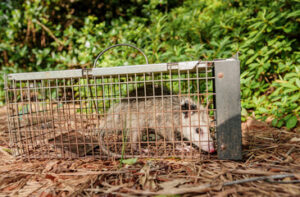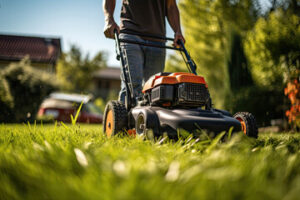When it comes to preventing wildlife from invading your property, prevention is the best and most humane approach. These strategies include regularly inspecting the yard and perimeter and reducing access to food, shelter, and water.
Regularly remove piles of brush, logs, debris, and trash. Stash firewood away from your home. Keep grass mowed and avoid overgrown vegetation that provides shelter. Read on or call Trapping USA Animal Removal & Pest Control to handle the job for you.

Seal Off Entry Points
Wildlife pests can damage your property and make a mess of it. Rodents, skunks, and raccoons leave droppings and can chew through wires or break into buildings to seek warmth and shelter. They can also spread diseases and cause significant structural damage to homes, sheds, and outbuildings.
A few simple steps can help you deter nuisance wildlife from your property and protect it from the harm they can cause. During regular inspections, check for animal droppings, tracks, or signs of digging or chewing in your yard. Also look for holes and cracks, especially near eaves, foundations, or chimneys, and keep an eye out for nests and burrows. If you spot any signs of a wildlife invasion, seal off entry points with caulk or expandable foam. For larger gaps, a wire mesh or other material that can’t be chewed through should be used.
Also, consider using commercial animal repellents designed to deter specific species. Applying these sprays around the perimeter of your home can be effective and environmentally friendly. Regularly clean your garbage bins, remove bird feeders at night, and trim vegetation to reduce food sources that can attract animals.
Keeping wild animals from entering your home is vital for your family’s safety and comfort and to prevent costly repairs. In addition to sealing off entries into your attic and crawl spaces, repair any damaged areas including rotting wood, damaged insulation, and soffits, and fix electrical wiring that may have been chewed or left exposed to the elements.
Humanely Evict The Animals
Many species of wildlife can cause major damage to homes, cars, and outbuildings when they encroach on human spaces. From raccoons digging in trash cans to squirrels chewing through electrical wires, wildlife pests often cause costly problems for homeowners and businesses. Additionally, many of these animals can carry diseases or parasites that pose health risks to humans and pets. By taking preventative measures to avoid wildlife intrusions, you can help maintain a natural balance in ecosystems and safeguard the well-being of your household.
A wildlife removal specialist can identify and seal entry points to prevent animal invasions. They can also provide inspections and advice to prevent future infestations. They can recommend specific deterrents based on your location and the specific species of animal involved in the problem. For instance, a deterrent such as motion-activated lights can scare away nocturnal animals like raccoons and skunks that may be lurking around your property. Regular yard maintenance can also be an effective way to deter wildlife, including keeping trees and shrubbery trimmed and free of brush that could provide shelter.
Professional wildlife removal experts will begin their work by assessing the situation and identifying the species involved. They will then develop a plan to remove the animals using appropriate trapping techniques. They will take care to minimize stress to the animal during this process. It is important to note that it is illegal to relocate an animal outside of your property. This can spread diseases, such as rabies, and it can also create conflicts with neighbors. This is why it is best to leave the relocation process to a reputable wildlife removal company.
Relocate The Animals
Wild animals can cause damage to your home and yard, including chewing on electrical wires, destroying structures, and posing health risks by spreading diseases like rabies or Lyme. Proper animal removal is essential to protect your property and ensure your family’s safety. Professionals use humane methods to capture and remove wildlife infestations from crawl spaces, attics, and walls, then disinfect and repair the areas they’ve infested.
When a raccoon is rummaging through your garbage, or squirrels are building a nest in your attic, you need to act quickly to prevent further problems. These creatures are looking for food and shelter, which you can provide by sealing off entry points, storing garbage bins in secure areas, trimming overgrown vegetation, and avoiding leaving out trash or pet food.
It is illegal to live trap and relocate a wild animal off your property, so if you see signs of wildlife in your crawl space, attic, or wall cavities, call a nuisance wildlife control operator right away. They’ll assess the situation, identify the species of animal, and then implement a removal strategy that’s safe for both you and the animals.
If your home is overrun with pests, they’ll also inspect and seal any problem areas to prevent future reentry. Choosing a company that exclusively offers nuisance wildlife control services is best, as they’ll have the training and experience to know where to relocate trapped animals and can prevent future infestations with one-way doors and other exclusion techniques. Find a professional who’s dedicated to animal control and has the proper licensing to handle wildlife. Also, look for someone who has a solid reputation, uses a hands-off approach to catching animals, and employs humane relocation practices with one-way doors.
Repair Damage
Wildlife is opportunistic and will take advantage of any opportunity to gain entry to your home or structure. Wood rot, cracks and gaps, and the enticing scent of nesting materials present ideal conditions for squirrels, birds, raccoons, mice, or other critters to find a way inside. Once inside, their job is to make dens or nests for their young. This results in significant collateral damage from chewed insulation and wire, water leaks, and drafts. Wildlife also leaves behind feces and urine, which cause severe property damage and must be dealt with.
Preventive measures, such as regular inspections and sealing off access points, are key to preventing the return of unwanted animals. Look for droppings, gnaw marks, tracks, and nesting material to identify species and determine the extent of any new infestations. Keep food sources away by securing garbage bins, removing pet food, and keeping branches and shrubs trimmed. Also, use commercial animal repellents to deter species specific to your area.
A good way to prevent wildlife problems is to contact a professional for animal removal and prevention services. A skilled technician will inspect your property to locate and fortify potential entry points. The technician will also conduct a risk assessment to help you prioritize strategies that are safe and effective for both the animal and your property. In addition, a reputable wildlife removal company will follow ethical guidelines that promote the welfare of all animals involved. Choosing a company that specializes in wildlife removal is a sure way to avoid a costly mess for both you and your property. Contact the professionals today to learn more about their services.
Prevent Future Infestations
Wildlife can wreak havoc on your home and property, causing structural damage, electrical hazards, sanitary issues, and more. Additionally, they can carry diseases and parasites that pose health risks to humans and pets. To protect your home and prevent future infestations, it is best to seek the help of professional wildlife removal services. A reputable company will inspect and identify potential entry points, then they can seal them off, humanely evict the animals, and disinfect any areas where wildlife has been present.
Many homeowners try DIY strategies to keep wildlife away from their homes, but these methods can be ineffective and may even lead to animal suffering. Furthermore, some species of wildlife are protected by law and cannot be removed without a permit. A trained wildlife removal expert will have in-depth knowledge of local animal behavior and habitats, allowing them to implement the most effective prevention strategies.
As residential areas continue to encroach on wildlife habitats, it’s important to be proactive about preventing wildlife invasions. Some of the most effective ways to deter wildlife include securing garbage bins and compost piles, keeping pet food in a secure place, trimming overhanging branches, and regularly cleaning your yard.
If you have a backyard vegetable garden or fruit trees, it’s also essential to remove fallen produce and leaves promptly to eliminate hiding places for wildlife. Regularly mowing your lawn will also reduce the number of potential animal shelters. In addition, installing a fence can prevent wildlife from gaining access to your property and encourage them to find refuge elsewhere. Finally, motion-activated lights can deter nocturnal animals like raccoons and skunks from hanging around your house. Homeowners can also use ultrasonic deterrents that emit high-frequency sounds that are unpleasant for animals but inaudible to humans.
